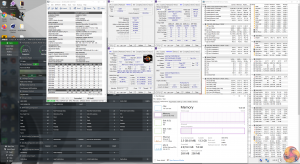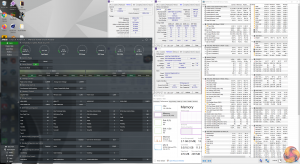We will be outlining the Klevv Bolt XR and Cras XR RGB DDR4 memory kits performance with the AMD Ryzen 9 5950X CPU, ASUS ROG Crosshair VIII Hero motherboard, and a Gigabyte RTX 3080 Eagle OC graphics card.
The processor is overclocked to a static 4.6GHz to take any clock speed variability from Precision Boost 2 out of the performance equation.
By default on AMD, 4000MHz memory will deliver a 2000MHz memory clock and therefore a 1000MHz memory controller clock due to the 2:1 divider.
If, however, we can get the Infinity Fabric clock to match the memory clock, we can also run the memory controller clock at the same speed and remove the 2:1 divider latency penalty. Unfortunately, our 5950X doesn’t want to seem to go higher than 1900 MHz for the Fabric Clock.
This means that we have two test procedures:
- We test the kit at stock 4000MHz XMP with the Ryzen system running without adjustment beyond a 4.6GHz CPU OC. This results in 1800MHz Fabric clock, 2000MHz memory clock, and 1000MHz memory controller clock.
- We also test with the memory running alongside a CPU configuration better tuned for high speed memory. This is 1900MHz Fabric clock, 1900MHz memory clock, and 1900MHz memory controller clock. Here, the memory was running at DDR4-3800MHz speeds.
It will be interesting to see how the higher memory speed but lower processor clock configuration will affect performance. Running 1900MHz Fabric Clock 1:1:1 is another benefit that high speed memory such as these KLEVV kits give us over the typical recommendation of DDR4 3600MHz kits.
Another minor point is that our ASUS motherboard refused to acknowledge CL19 despite the XMP settings being programmed correctly. As such, we manually tuned the kit to run at CL18 by default. This is technically an overclock but it was perfectly stable and gave us a reasonable workaround.
Test System:
- Processor: AMD Ryzen 9 5950X overclocked to 4.6GHz all core.
- Motherboard: ASUS ROG Crosshair VIII Hero.
- Graphics Card: Gigabyte RTX 3080 Eagle OC.
- System Drive: WD_Black SN750 SSD.
- CPU Cooler: Fractal Celsius+ S28 Prisma 280mm AIO.
- Power Supply: Seasonic Prime TX-1000 1000W.
- Case: Lian Li Open-air Test Bench.
- Operating System: Windows 10 Pro 64-bit.
Comparison Memory Kits (1:1:1 FCLK:UCLK:MCLK where applicable):
- 2x16GB Patriot Viper Steel RGB 3600MHz 20-26-26-46 (Hynix AFR ICs, dual rank configuration)
- 4x8GB Corsair Dominator Platinum RGB (White) 3600MHz 18-19-19-39 (Micron E-die ICs, effective dual rank configuration)
- 2x32GB Patriot Viper Steel 3600MHz 18-22-22-42 (SpecTek MT40 ICs, dual rank configuration)
- 2x16GB Corsair Vengeance RGB Pro SL 3600MHz 18-22-22-42 (Micron D9XPF B-die ICs, single rank configuration)
Tests:
- 7-Zip – Built-in 7-Zip benchmark test (CPU & Memory)
- Cinebench R20 – All-core & single-core CPU benchmark (CPU & Memory)
- Blender 2.90 – All-core rendering of the Classroom benchmark (CPU & Memory)
- SiSoft Sandra – Memory bandwidth (Memory)
- AIDA64 – Memory bandwidth, memory latency (Memory)
- 3DMark TimeSpy – Time Spy (1440p) test (Gaming)
- Shadow of the Tomb Raider – 1920 x 1080, Highest quality preset, no AA, DX12 version (Gaming)
 KitGuru KitGuru.net – Tech News | Hardware News | Hardware Reviews | IOS | Mobile | Gaming | Graphics Cards
KitGuru KitGuru.net – Tech News | Hardware News | Hardware Reviews | IOS | Mobile | Gaming | Graphics Cards







